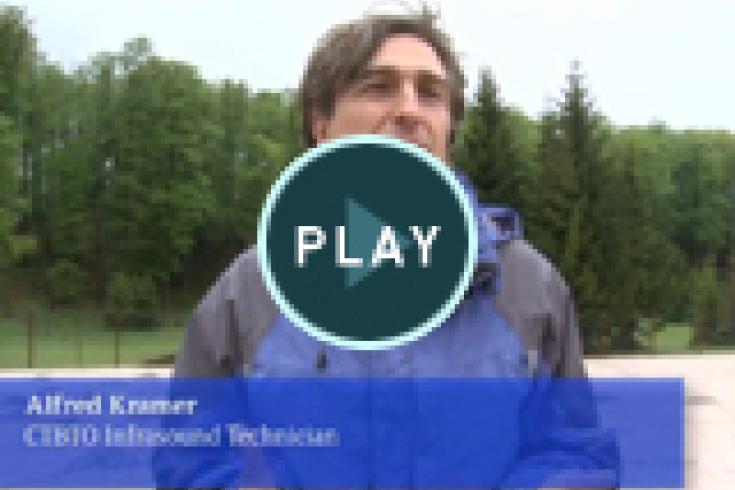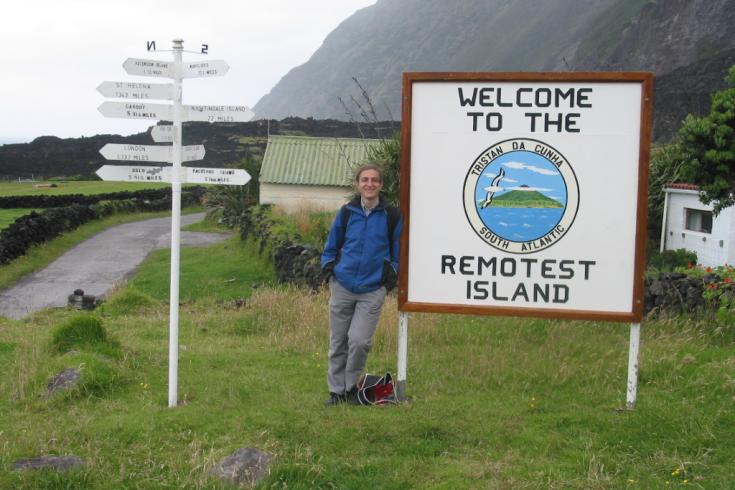Listening without sound - CTBTO engineers refine a unique technique
Among them is Alfred Kramer, an Austrian electronics engineer, who is explaining the function of dozens of molehill like mounds of gravel, linked by spokes of tubes to raised hubs, within a security fenced enclosure.
There are, at a variety of mostly isolated locations on earth, more than 40 sites using similar equipment, as puzzling to the uninitiated as Prince Henry the Navigator’s compass rose, with which the infrasound arrays at first glance look alike, must have appeared in the fifteenth century.
This complex is in Austria, not 90 minutes from the heart of its capital Vienna, in a range of limestone hills that extend south of the city, near the bucolic village of Muggendorf.
And as Kramer is explaining, to a news crew from the Austrian national broadcaster ORF, the strange pipe arrays are test beds for a relatively obscure technology that is part of a global system to detect nuclear explosions.
Inaudible Sounds
Kramer is a technician with the Preparatory Commission for the Comprehensive Nuclear-Test-Ban Treaty Organization (CTBTO) and the Trafelberg facility is a proving ground for infrasound, which is able to detect sounds below the ability of the human ear to hear.

New Facility to Improve Detection of Nuclear Explosions.
Presently more than 250 stations transmit, mostly by satellite, data from seismic, hydroacoustic, radionuclide and infrasound monitoring stations to the CTBTO’s International Data Centre in Vienna. When the CTBTO International Monitoring System (IMS) is completed it will keep watch from 337 facilities.
On this unseasonably cold and blustery day -- snow is falling at an elevation just a few hundred metres higher -- the CTBTO facility, at the Conrad Observatory, one of Europe’s most modern earth science research stations, is having its official opening.
Least Magnetic Location
The observatory, seven km. from the nearest public road, is operated by the Austrian Central Institute for Meteorology and Geodynamics (ZAMG). Its location was selected because this is the least magnetic site in Austria.
Viktor Conrad, for whom the observatory is named, was a famous Austrian seismologist whose socialism put him at odds with Austria’s Nazi rulers and led to his exile in the United States in 1938. Upon his death in 1962, his widow bequeathed most of the couple’s assets to the establishment of the observatory.
The infrasound test facility provides the CTBTO with the tools to refine a technology whose development at the time the Treaty was signed in 1996 had been neglected for over 30 years.
“Infrasound has a potential that is not fully understood or fulfilled,” diplomats and journalists attending the opening are told by Federico Guendel, Director of the International Monitoring System.

Infrasound test facilities at the Conrad Observatory.
The visitors have been brought to the top of the Trafelberg by bus on a switchback service road through forest seven kilometres from the nearest public road.
Infrasound technology has its scientific roots in the eruption of the Krakatoa volcano in Indonesia in 1883 when waves from the event travelled around the world and were detected thousands of kilometres away.
Infrasound, like sound, is carried in the air by waves, known as infrasonic waves. Although they are of such low frequency as to be inaudible they cause a change in air pressure that is detectable as a barometer registers changes in air pressure from weather variability.
Infrasonic waves travel at the speed of sound and can carry over long distances without losing strength: their enemy, however, is noise generated by wind turbulence. If the amplitude of the infrasonic wave at the receiver is greater than that of the noise it can be easily measured, says Kramer; otherwise the signal is hard to distinguish.
Ideally, to suppress wind noise infrasound facilities would be located in forested areas. That’s an improbable wish Kramer says, when many of the 42 CTBTO infrasound facilities, and 18 more still to be built, are in treeless regions such as Antarctica and Greenland.
Wind Noise
Which is the purpose, Kramer explains, for the pipe arrays and the mounds of gravel covering each of the inlet ports at the outer extent of the slim stainless steel pipes.
“They reduce wind noise. The main purpose of the test bed is to determine the performance of wind noise reduction systems and compare results,” Kramer said.
Communication installation for three stations on the island of Tristan da Cunha.
Infrasound is produced in nature by volcanoes, earthquakes, meteors, storms and auroras. Man-made sources are mining, large chemical explosions, aircraft and rocket launches as well as nuclear explosions.
In the Cold War, at the height of nuclear weapons testing in the atmosphere, infrasound was one of the techniques employed to detect explosions. But upon introduction of the Partial Test Ban Treaty (PTBT) in 1963 its use declined.
Kramer joined the CTBTO in 2001, since when he’s been involved in establishing infrasound stations from the Cocos Islands in the Pacific to Tristan da Cunha in the south Atlantic as well as maintaining them. “I’ve learned how to install infrasound facilities anywhere on the planet,” he said.
Revived Interest
Since the advent of the CTBTO and the rejuvenation of infrasound technology there’s been growing interest in it among scientists and technological advances are strengthening it.
The Conrad observatory facility where four different infrasound configurations are currently being tested offers engineers, such as Kramer, the opportunity to evaluate new equipment and better set technical specifications for suppliers to meet.
Seismometers have also been installed beside the infrasound arrays to test how the two technologies that provide waveform data can enhance each other.
The facility will also be used for training by the CTBTO while cooperation with the Austrian ZAMG meets the goals of the Treaty to developing stronger ties with scientists to help advance its verification capabilities. “It’s a good fit,” said Peter Melichar, former head of the observatory. “Austria is very supportive of the Treaty. We all benefit from this arrangement.’’

Infrasound facilities are located in some of the most remote places on earth -- Alfred Kramer in Tristan da Cunha.
17 Jun 2010
